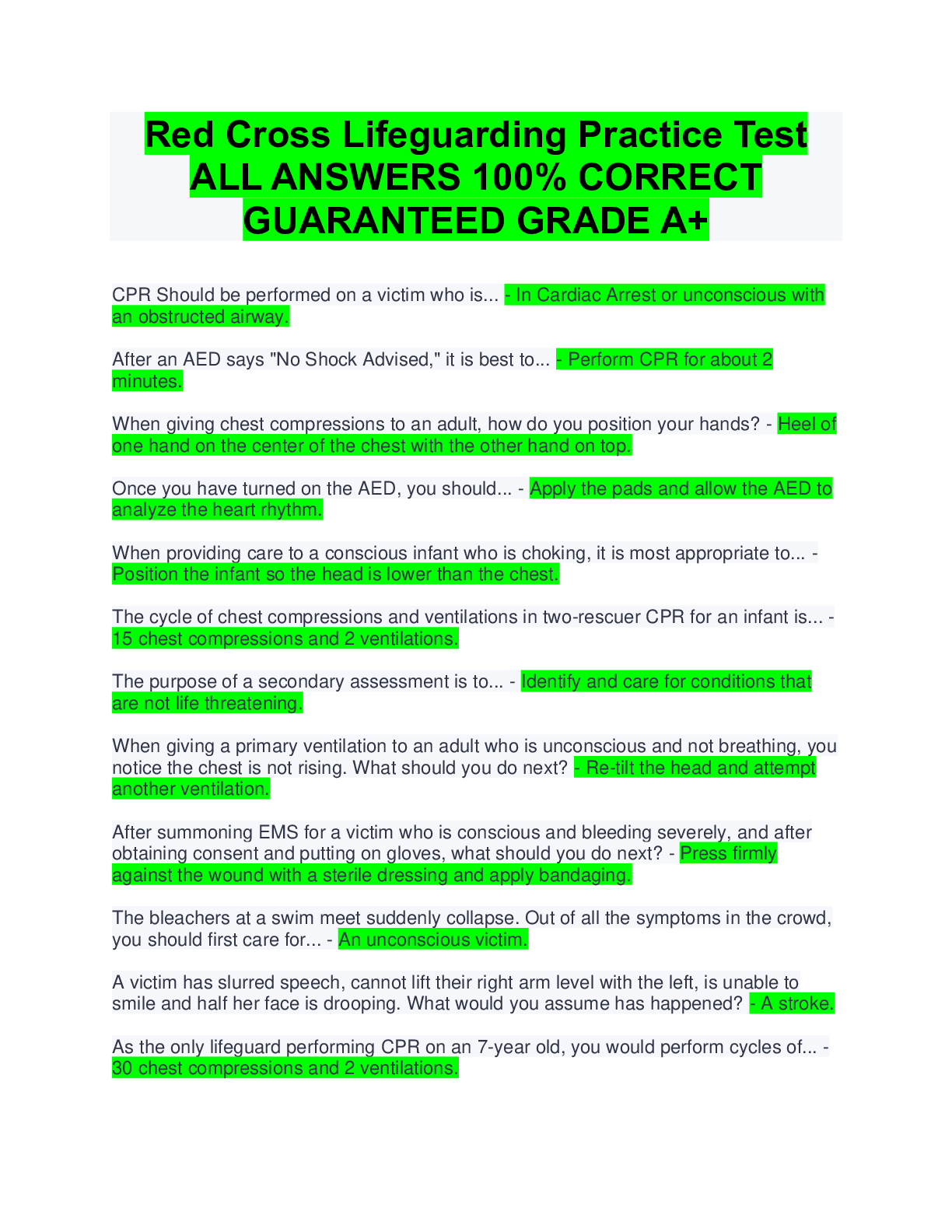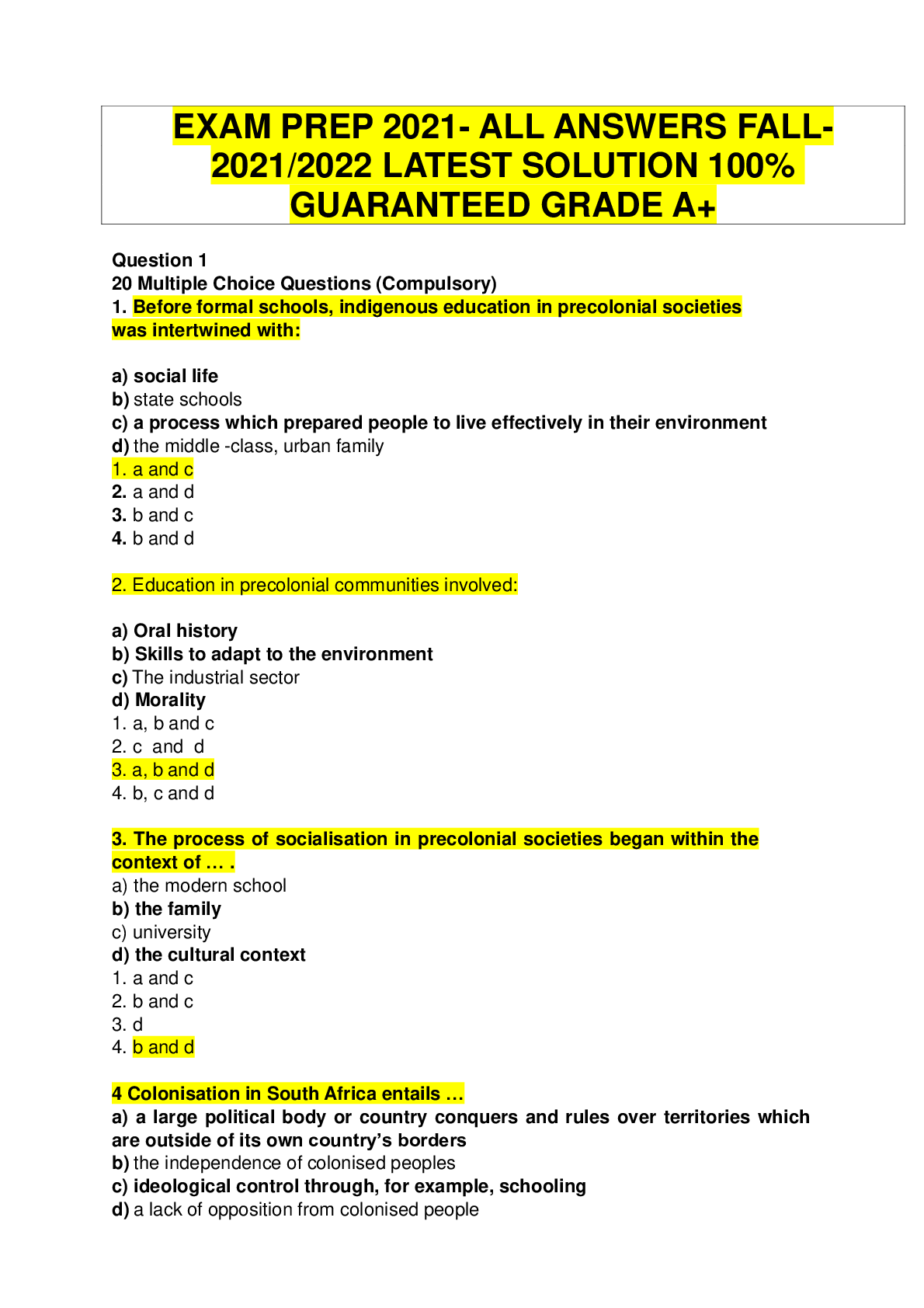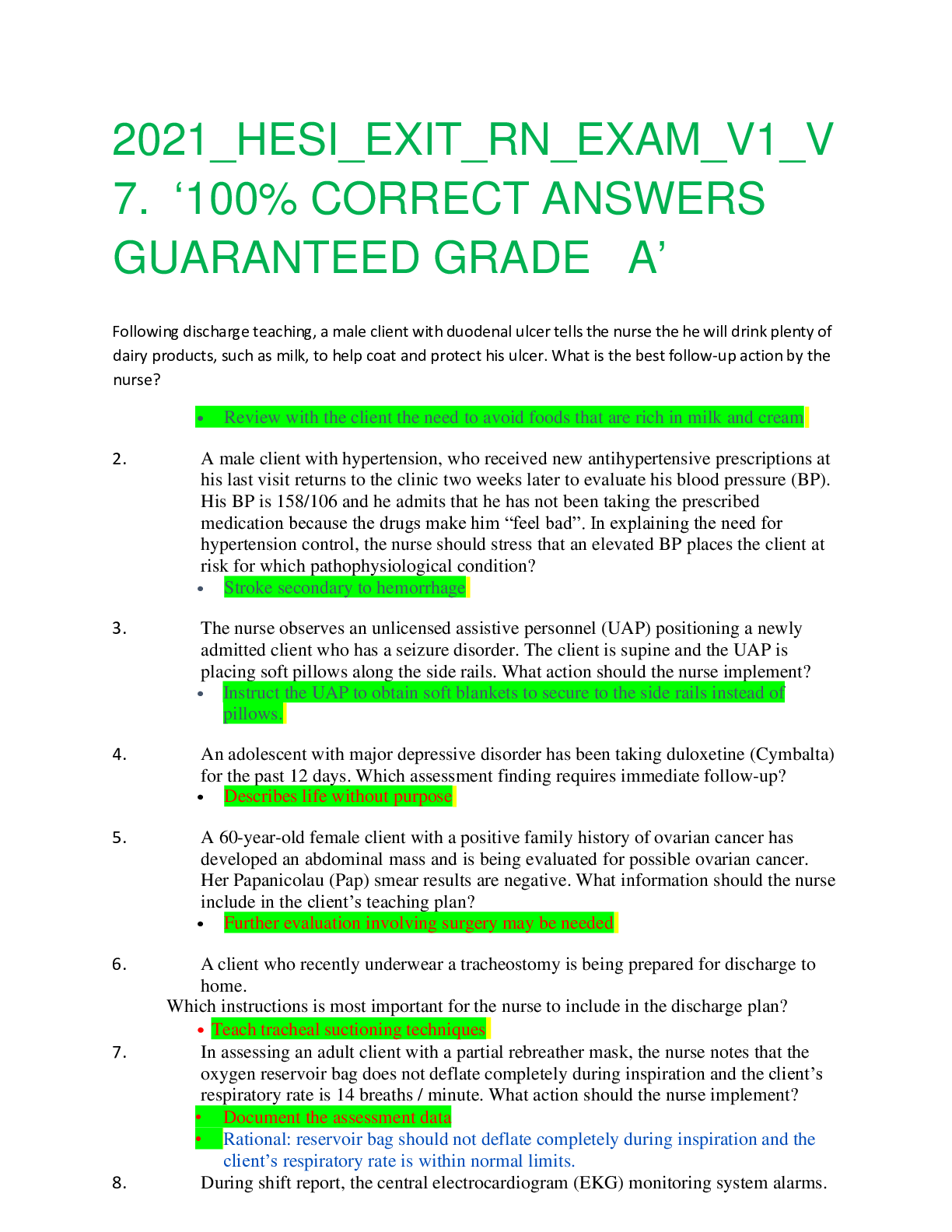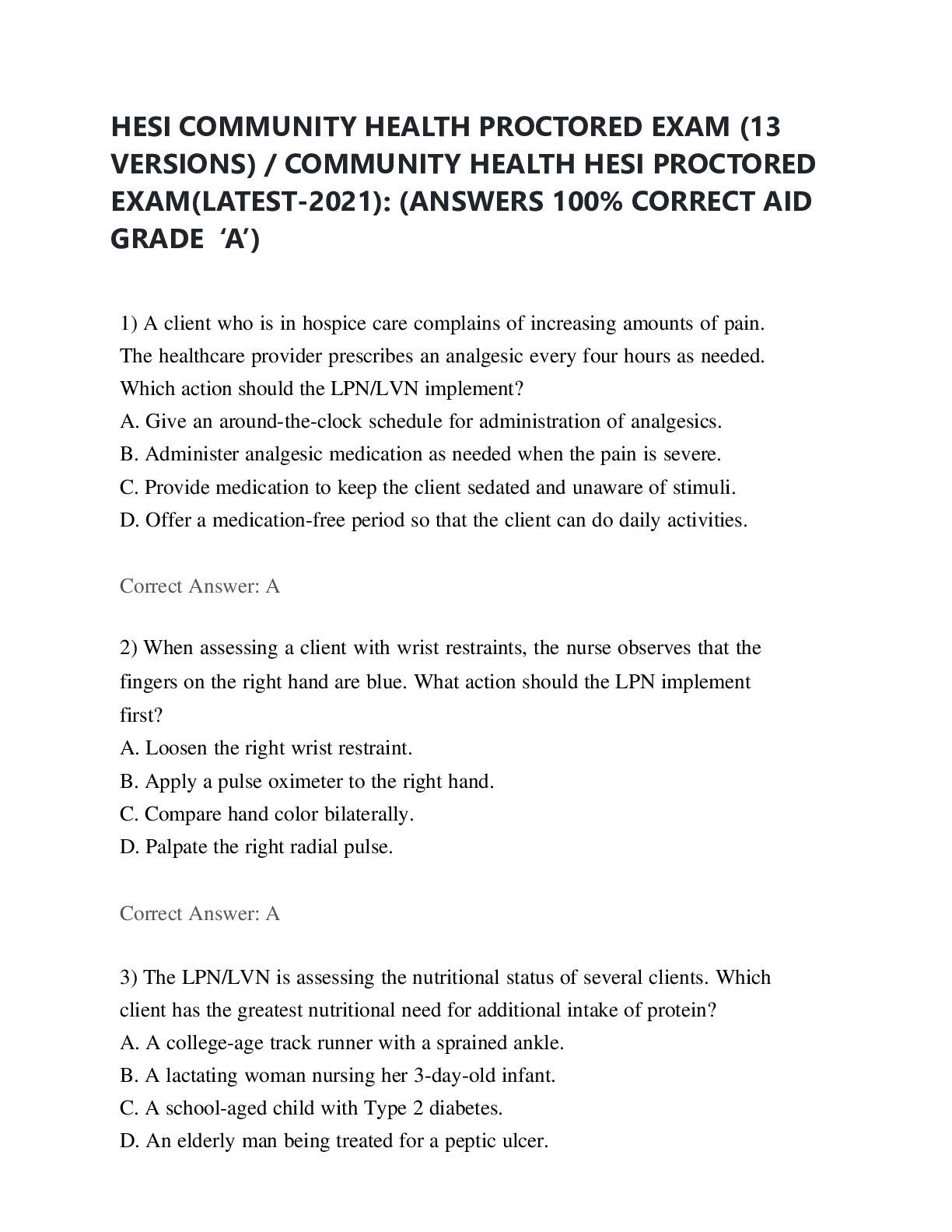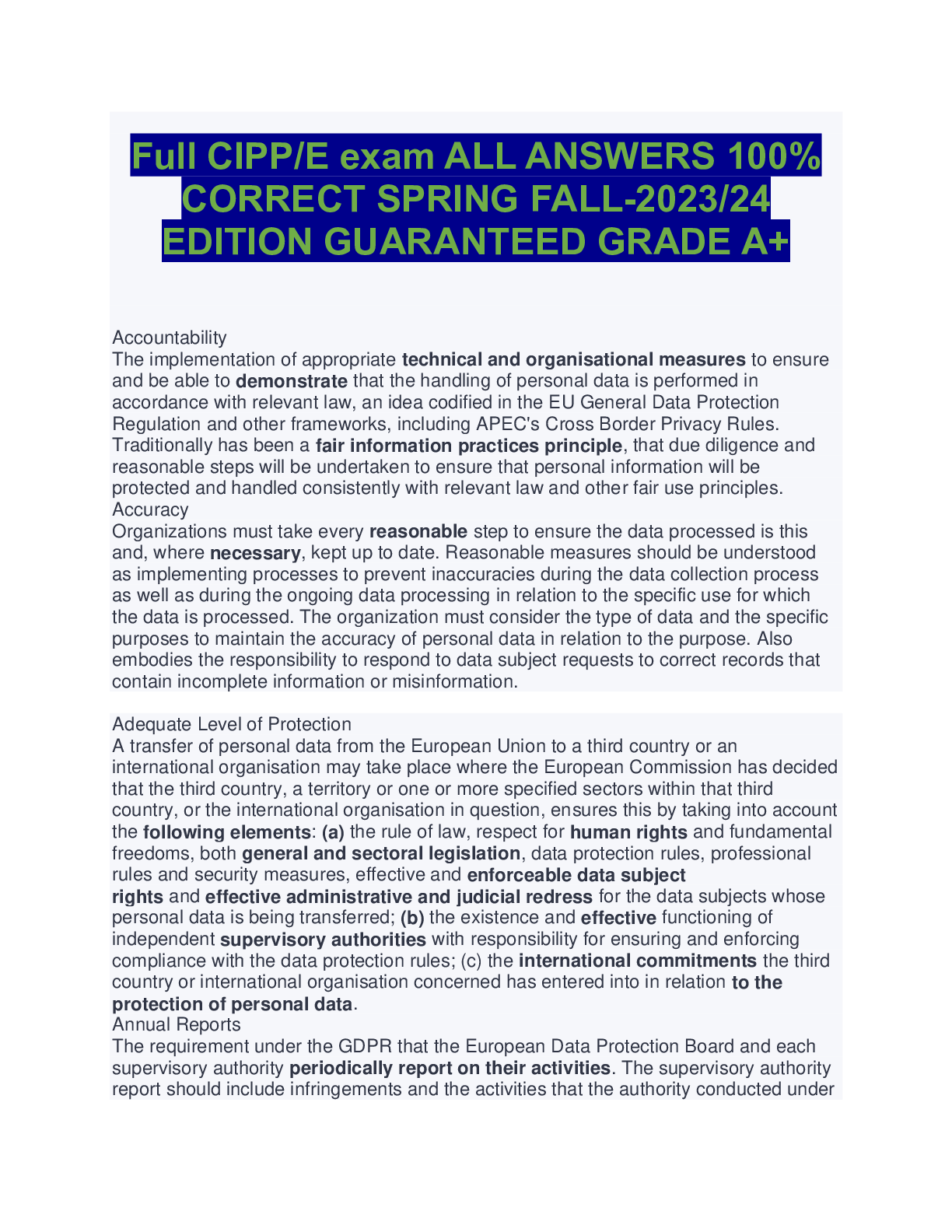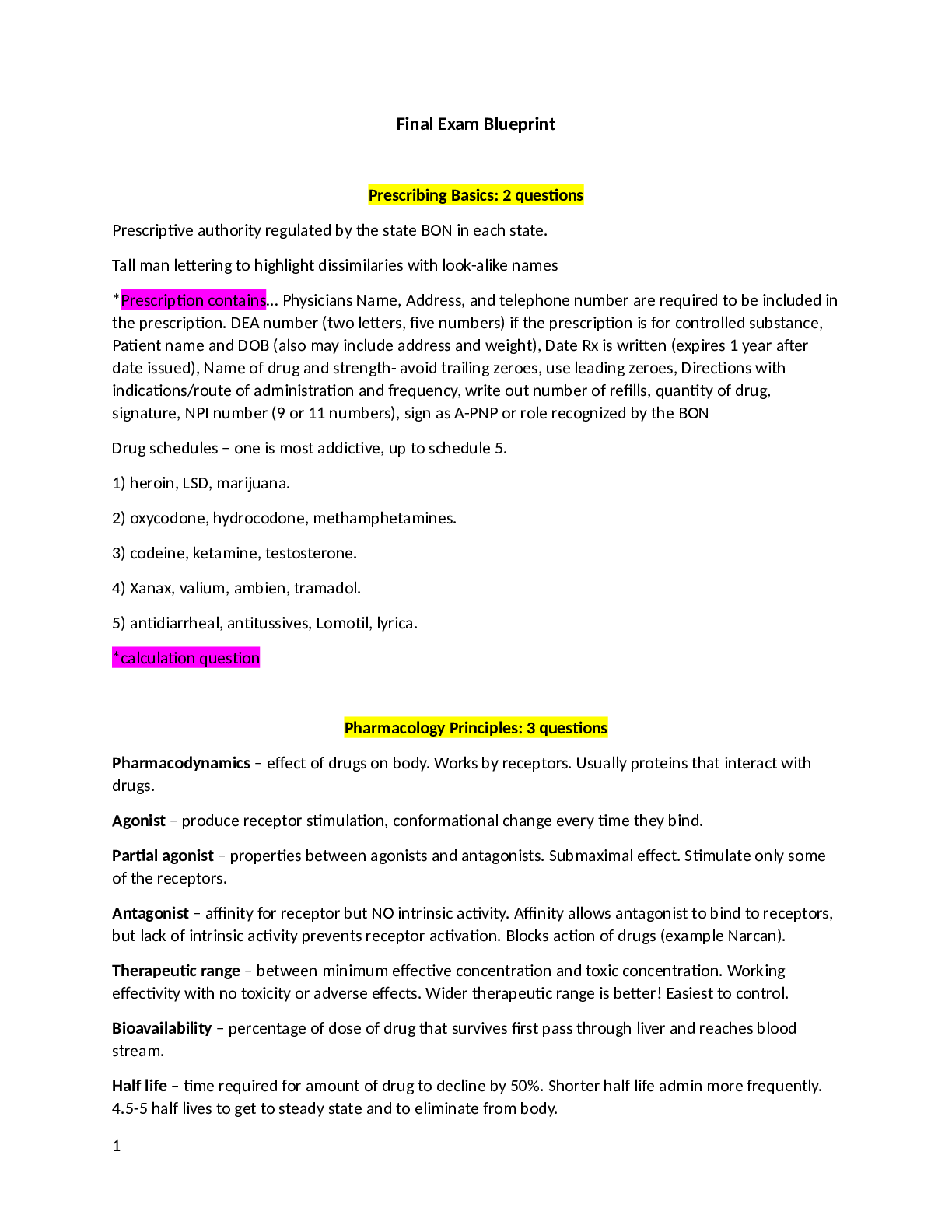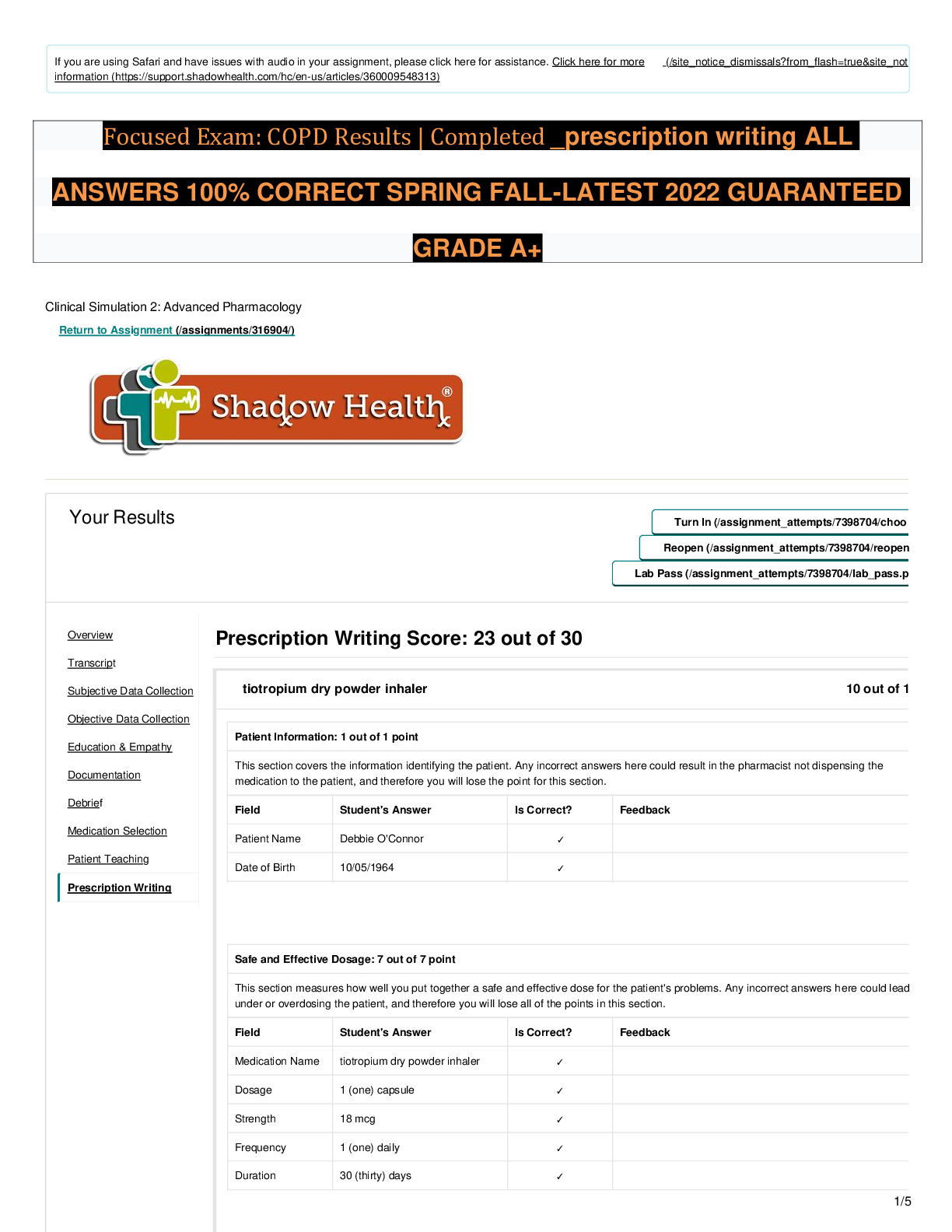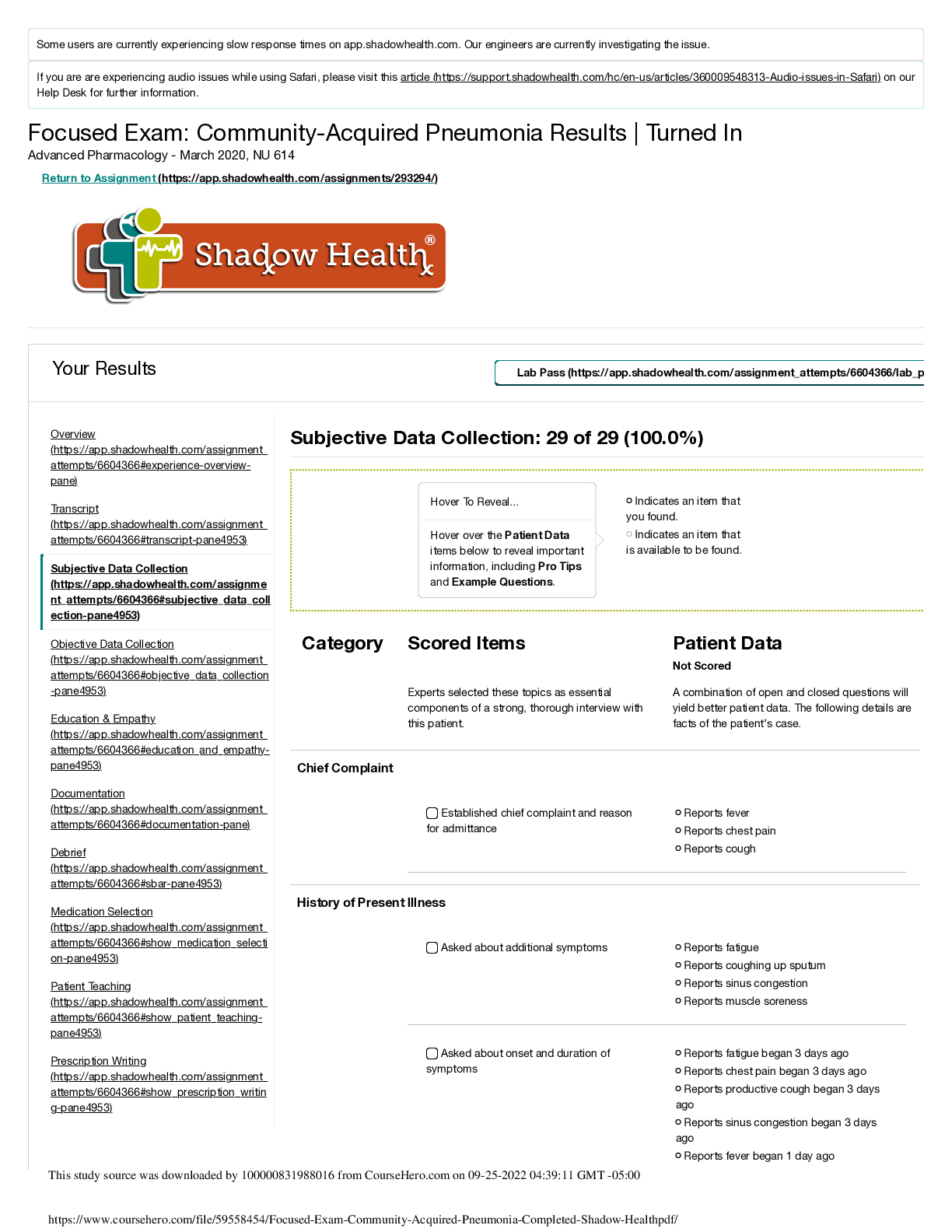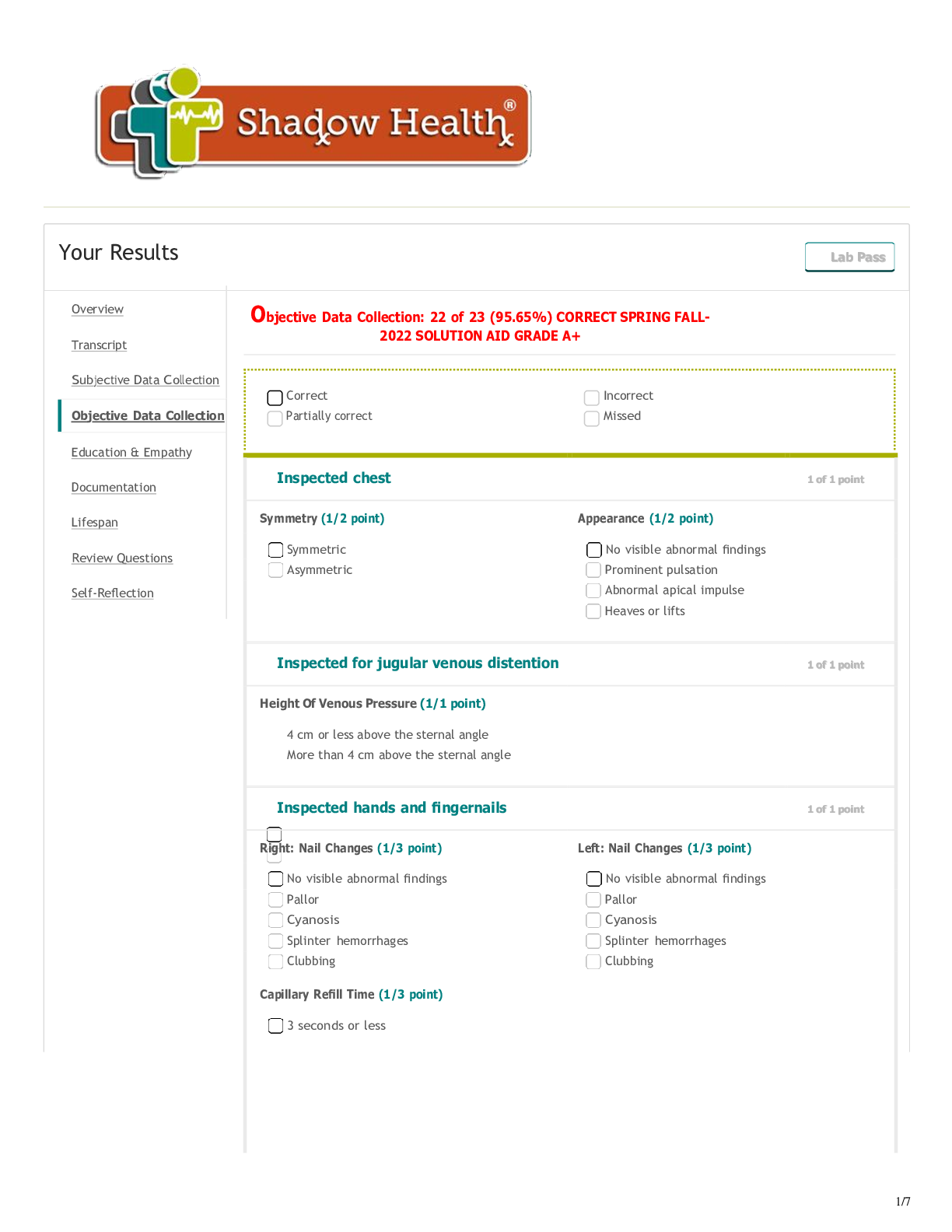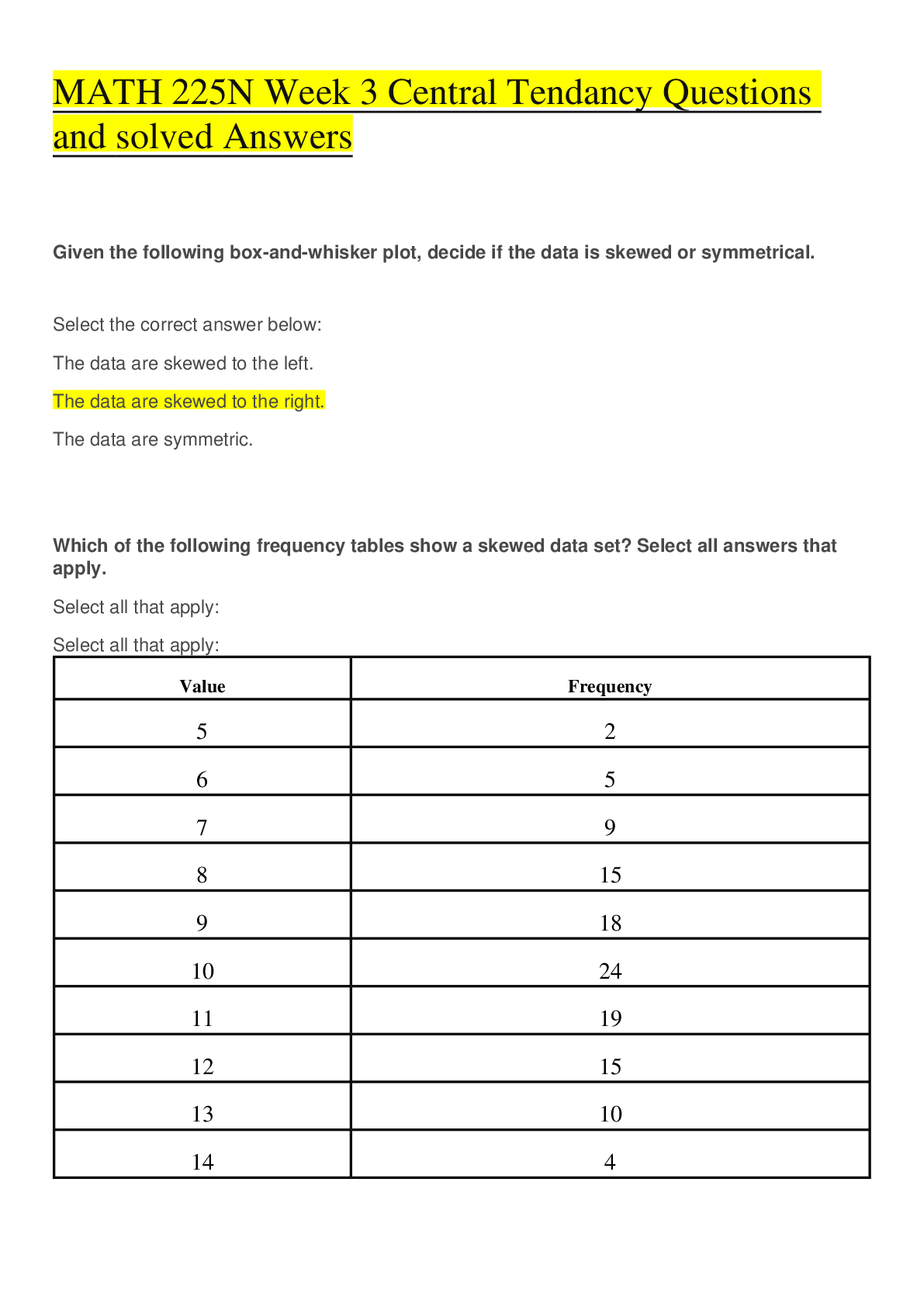*NURSING > EXAM > Chapter 14: Personality Disorders ALL ANSWERS 100% CORRECT LATEST SOLUTION SPRING FALL-2022 GUARANTE (All)
Chapter 14: Personality Disorders ALL ANSWERS 100% CORRECT LATEST SOLUTION SPRING FALL-2022 GUARANTEED GRADE A+
Document Content and Description Below
1. When analyzing the behaviors of a 23-year-old who meets the criteria for antisocial personality disorder, the nurse recognizes that which nursing diagnosis would be pertinent to his care? a. R... isk for self-mutilation b. Disturbed personal identity c. Impaired social interaction d. Social isolation ANS: C The patient with antisocial personality disorder is impulsive, manipulative, and dishonest. Patients with this disorder are frequently involved in illegal matters. Self-mutilation and disturbed identity are more appropriate for patients with borderline personality disorder. Social isolation would apply more readily to Cluster A disorders. DIF: Cognitive Level: Comprehension REF: Page 306 TOP: Nursing Process: Diagnosis MSC: NCLEX: Psychosocial Integrity 2. Which observation is supportive of a diagnosis of avoidant personality disorder? a. Talks about “my three failed marriages” b. Cries loudly whenever requests are denied c. Fears criticism from others, including staff d. Shows no remorse when accidentally breaking another patient’s bracelet ANS: C Symptoms suggesting an avoidant personality disorder include fear of rejection, avoidance of relationships, and censorship of expression of thoughts and feelings because of fear of a negative reaction. Borderline personality disorder presents with unstable interpersonal relationships, labile affect, and complaints of emptiness. Patients with histrionic personality disorders are overly dramatic, manipulative, and attention-seeking. Patients with schizoid personality disorder are indifferent to and lack concern for interpersonal contacts. DIF: Cognitive Level: Application REF: Page 305 | Page 307 TOP: Nursing Process: Assessment MSC: NCLEX: Psychosocial Integrity 3. Which behavior is supportive of a diagnosis of dependent personality disorder? a. Perceives personal behavior to be embarrassing b. Believes they are incapable of functioning independently c. Tends to exaggerate the potential dangers of ordinary situations d. Demands excessive attention from others whenever in a group situation ANS: B The dependent person must rely on others to make decisions and assume responsibility of major areas of his or her life. Low self-esteem and exaggeration are seen in avoidant personality disorder. Attention seeking is seen in narcissistic personality disorder. DIF: Cognitive Level: Application REF: Page 307 TOP: Nursing Process: Assessment MSC: NCLEX: Psychosocial Integrity 4. When planning care for a patient with antisocial personality disorder, which consideration has greatest importance? a. Addressing the demand for constant attention b. Teaching coping skills related to frustration tolerance c. Identifying behaviors related to well-developed superegos d. Managing the manipulative behaviors resulting from a charming persona ANS: D Patients with antisocial personality disorder are described as charming because of their ability to size up and manipulate others. Narcissistic patients demand constant attention. Patients with histrionic personality disorder do not tolerate delay of gratification or frustration. Patients with personality disorder have poorly developed superegos. DIF: Cognitive Level: Application REF: Page 306 TOP: Nursing Process: Planning MSC: NCLEX: Psychosocial Integrity 5. When a patient diagnosed with borderline personality disorder experiences the death of a beloved parent, which characteristic response will the nurse anticipate? a. Denies the death for a protracted period of time b. Exhibits several different psychotic thought processes c. Expresses extreme anger and rage by burning the parent’s clothes d. Becomes uncharacteristically helpful and attends to the funeral arrangements ANS: C If a significant person in the patient’s life dies, the patient with borderline personality disorder cannot mourn but often exhibits one or more of the six constituent states that include anger and rage. The other options are not characteristically seen as mourning behaviors in individuals with this diagnosis. DIF: Cognitive Level: Application REF: Page 304 TOP: Nursing Process: Assessment MSC: NCLEX: Psychosocial Integrity 6. A 27-year-old woman diagnosed with borderline personality disorder displays a labile affect, impulsivity, frequent angry outbursts, and difficulty tolerating her angry feelings without self- injury. A priority nursing diagnosis for this patient is: a. Anxiety b. Risk for self-mutilation c. Risk for other-directed violence d. Ineffective coping ANS: B Patients with borderline personality disorder frequently engage in self-mutilation in an attempt to manage chaotic feelings. The important clue to this diagnosis is that the patient is having difficulty tolerating feelings without self-injuring. There is no data to support anxiety or ineffective coping. The risk is greater for violence toward self. DIF: Cognitive Level: Application REF: Page 306 TOP: Nursing Process: Diagnosis MSC: NCLEX: Physiological Integrity 7. Which outcome has priority for a patient with borderline personality disorder being discharged from an outpatient treatment environment? a. Patient demonstrates control over self-destructive impulses. b. Patient can identify symptoms that indicate a need for psychotherapy. c. Patient demonstrates an understanding of the importance of medication compliance. d. Patient actively participates in a community 12-step group related to relevant care. ANS: A The patient’s ability to control self-destructive impulses has priority over the other options because doing so will affect patient safety. DIF: Cognitive Level: Analysis REF: Page 310 TOP: Nursing Process: Assessment MSC: NCLEX: Physiological Integrity 8. A patient who is diagnosed with schizoid personality disorder is isolative, does not speak to her peers, and sits through the community meeting without speaking. Her mother describes her as shy and having few friends. Which would be an appropriate nursing diagnosis for this patient? a. Anxiety related to a new environment as evidenced by isolation and not talking with peers Ineffective coping related to new environment as evidenced by isolation and minimal b. interaction with others Impaired social interaction related to unfamiliar environment as evidenced by isolation and c. not talking with peers Disturbed thought processes related to a new environment as evidenced by isolation and d. minimal interactions with others ANS: C This nursing diagnosis relates directly to her symptoms and their underlying pathology. Data are not present to support the other options. DIF: Cognitive Level: Application REF: Page 306 TOP: Nursing Process: Diagnosis MSC: NCLEX: Psychosocial Integrity 9. The nurse is careful to provide a quiet, comfortable, safe environment when conducting an assessment interview. What is the reason this is particularly important when working with a patient believed to be exhibiting characteristics of a personality disorder? These patients are generally experiencing chronic depression and are severely impaired a. socially. A high stimulus environment will cause the patient to exhibit exacerbated behaviors that are b. loud and attention seeking. The patient is easily intimidated and may become so withdrawn that the assessment will be c. difficult if not impossible to complete. d. This disorder produces defensive, guarded, and impulsive behavior that is easily provoked into anger when the patient feels threatened. ANS: D Individuals with these disorders are often withdrawn, defensive, guarded, and impulsive, and may demonstrate an escalation of anger or make hostile or threatening comments. The remaining options are specific to certain types of personality disorders. DIF: Cognitive Level: Application REF: Page 309 TOP: Nursing Process: Implementation MSC: NCLEX: Psychosocial Integrity 10. When facilitating change in the behavior of a patient diagnosed with a personality disorder, which intervention will have the greatest impact on success? a. Collaborating with the patient when establishing treatment goals b. Educating the patient to the importance of complying with treatment interventions c. Evaluating the patient’s understanding of the etiology of the prescribed medications d. Conducting regular assessments so the treatment can be changed when necessary ANS: A When planning interventions with a patient who has a personality disorder, it is important to recognize that the person has disturbed values that do not reflect the views held by the general population. Because of these disturbances, the nurse needs to collaborate with the patient [Show More]
Last updated: 2 years ago
Preview 1 out of 20 pages
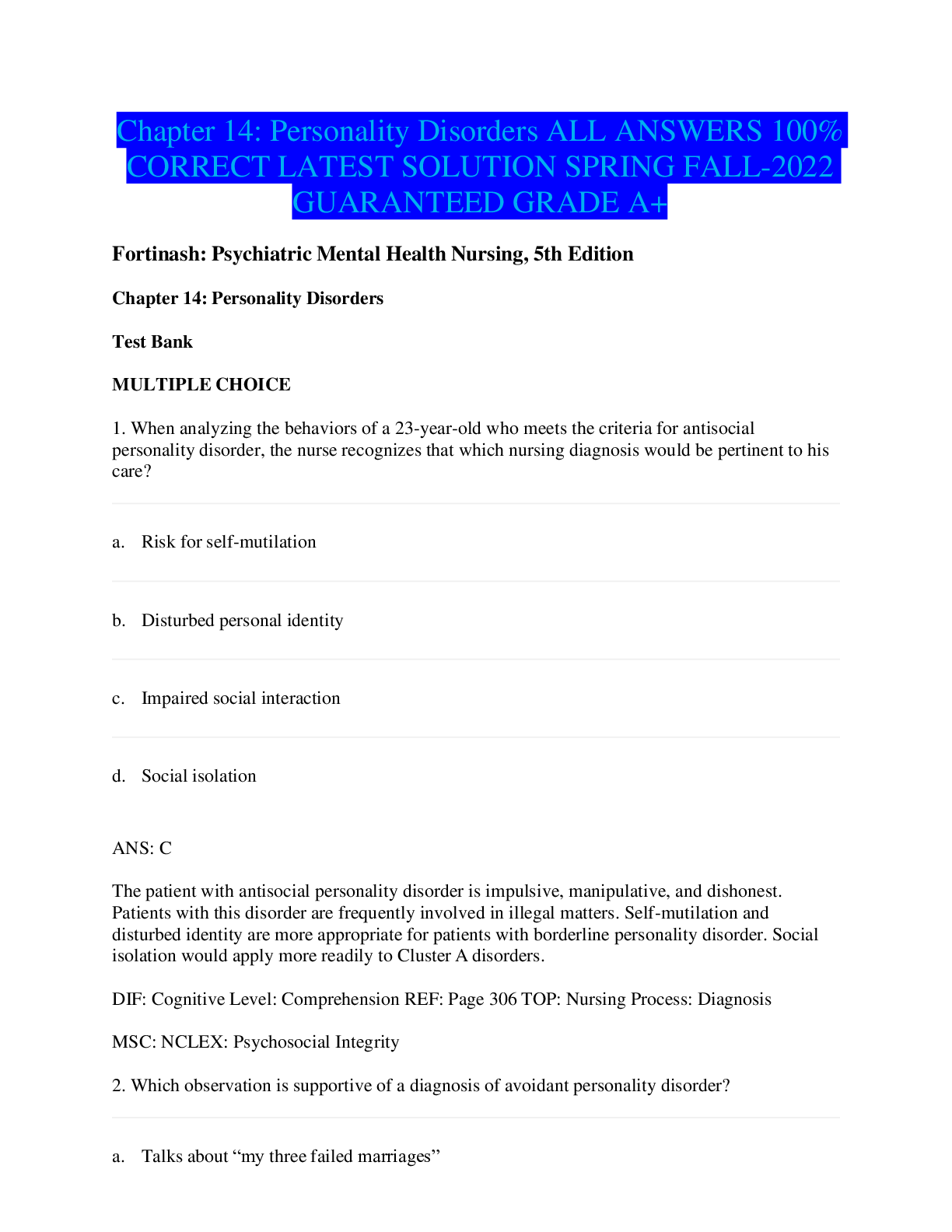
Buy this document to get the full access instantly
Instant Download Access after purchase
Buy NowInstant download
We Accept:

Reviews( 0 )
$13.50
Can't find what you want? Try our AI powered Search
Document information
Connected school, study & course
About the document
Uploaded On
May 16, 2022
Number of pages
20
Written in
Additional information
This document has been written for:
Uploaded
May 16, 2022
Downloads
0
Views
48

